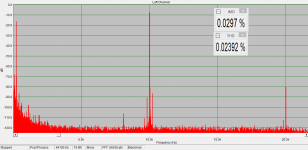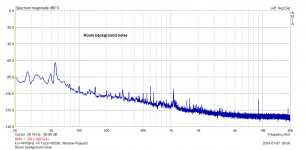However the authority wasn't really an authority and probably hasn't ever really done such work.
Some good references here, the article is of interest too.
Red Shift: Doppler distortion in loudspeakers | Stereophile.com
1. We don't want to include room response and reflections into distortion measurements, do we? Especially when posting recorded wav. So, we try to minimize room effect. For a 200Hz test, it was achieved by a near field measurement.
2. Flat on axis frequency response in a listener's place or measurement place does not automatically mean flat power response. Power response is a result of speaker directivity pattern and room reflections.
2. Flat on axis frequency response in a listener's place or measurement place does not automatically mean flat power response. Power response is a result of speaker directivity pattern and room reflections.
Reflections are not much of a concern looking for low level harmonics at the microphone distances in question.
Power response is more important when you listen to anything that varies in amplitude. For continuous noise steady state is not the same as direct plus reverberant field with amplitude variations.
My objection was to the article over simplifying real issues and missing the current preferred techniques for measuring frequency response in an echoic environment.
Power response is more important when you listen to anything that varies in amplitude. For continuous noise steady state is not the same as direct plus reverberant field with amplitude variations.
My objection was to the article over simplifying real issues and missing the current preferred techniques for measuring frequency response in an echoic environment.
I can see how you did that....
- Wow 8-o - lets register... Simon - no, Simon1 - no, Simon2 - no.... Simon7 - no w.t.... SIMON7000... Hurray :-D
🙂
//
- Wow 8-o - lets register... Simon - no, Simon1 - no, Simon2 - no.... Simon7 - no w.t.... SIMON7000... Hurray :-D
🙂
//
Why are we quibbling about speaker measurement techniques? Just measure the speakers harmonic or IM distortion with a decent measurement microphone.
Why not working with fixed frequencies and stop the recording in the time domain before the first réflexion hit the mic ?the current preferred techniques for measuring frequency response in an echoic environment.
Quite easy in large rooms/theaters.
(maybe it's been done since I left this area of activity ?)
Last edited:
We could run the driver free air and make use of the dipole effect (even off-axis) to drop the receiving SPL.[...]
I suspect the mic used for FR that are inexpensive though flat FR are Not good enough for THD measurements or low enough to see any improvements in speaker design/mods. How can we, the DIY'er, find out?
Why not working with fixed frequencies and stop the recording in the time domain before the first réflexion hit the mic ?
Quite easy in large rooms/theaters.
(maybe it's been done since I left this area of activity ?)
Done secretely since the late forties. Commercially since the seventies. With a sweep you be almost absolute in the tracking. All you need to know is the source to receiver distance.
1. We don't want to include room response and reflections into distortion measurements, do we? Especially when posting recorded wav. So, we try to minimize room effect. For a 200Hz test, it was achieved by a near field measurement.
2. Flat on axis frequency response in a listener's place or measurement place does not automatically mean flat power response. Power response is a result of speaker directivity pattern and room reflections.
Read the fine print ... I said you can window out any room reflections.
All good acoustic software can do this.
-RNM
Last edited:
Why are we quibbling about speaker measurement techniques? Just measure the speakers harmonic or IM distortion with a decent measurement microphone.
Because.... #1 .. we do not know what contribution to spkr THD comes from the micrphone. and #2 we need realistic power level driving the speaker but then also be far enough away to limit the spl at the mic (< distortion again).
If you mean a mega dollar B&K mic/preamp... sure that should be adequate. But this is DIY and who wants to spend a lot of money for just our curiosity or for only a few times use?
If there is a reasonably easy and low cost way to measure mic thd then Maybe we can find a cheaper mic that is adequate for this driver mod testing.
-Richard
Last edited:
Maybe this could be used --->
The input signal for this test is typically at 105 dB SPL, which is 11 dB above the reference SPL of 94 dB. THD is measured at a higher SPL than other specifications because, as the level of the acoustic input signal increases, the THD measurement typically increases as well. A rule of thumb is that the THD triples with every 10 dB increase in input level. Therefore, THD less than 3% at 105 dB SPL means that the THD will be less than 1% at 95 dB SPL.
-RNM
The input signal for this test is typically at 105 dB SPL, which is 11 dB above the reference SPL of 94 dB. THD is measured at a higher SPL than other specifications because, as the level of the acoustic input signal increases, the THD measurement typically increases as well. A rule of thumb is that the THD triples with every 10 dB increase in input level. Therefore, THD less than 3% at 105 dB SPL means that the THD will be less than 1% at 95 dB SPL.
-RNM
I am concerned that your 'rule of thumb' is fairly far off. As I know it: 2'nd harmonic goes directly as level, so it does go about 10dB or close to 3 times, but 3rd harmonic goes as the square, so it would be 10times with a 10dB in level. Therefore it would depend on whether 2'nd harmonic is totally dominant as the THD or not.
From my measurements of the B&K 4145 the second does seem to be dominant and its pretty low. I was just looking at that with a GR Omnical. At 114 dB the combination has 2nd at -55 dB and 3rd at -55 dB. That doesn't change at 104 dB or 94 dB. Its also virtually the same as the electronic signal. Also curious is that this calibrator uses current feedback. I may explore lowering the oscillator distortion and see if that helps.
doesnt change with level much? hmm seems like preamp/osc..... would not be useful for our purpose like that.
distortion is too high, also, at 94db spl.
THx-RNMarsh
distortion is too high, also, at 94db spl.
THx-RNMarsh
Last edited:
I am concerned that your 'rule of thumb' is fairly far off. As I know it: 2'nd harmonic goes directly as level, so it does go about 10dB or close to 3 times, but 3rd harmonic goes as the square, so it would be 10times with a 10dB in level. Therefore it would depend on whether 2'nd harmonic is totally dominant as the THD or not.
dont know... copied from others work and pasted it here. Note they said THD... not 2H or 3H.
-RM
Last edited:
I'm afraid not good enough in this case, the backround noise appears to cause contamination in this single tone test. I need to look at some data like 200Hz and 10kHz mixed from two separate sources. So ignore for now the first results.
Scott, here is a zip with 2 recorded files, 300Hz+10kHz and 200Hz+10kHz. Recorded from 2 sources, microphone placed about 10cm from the tweeter membrane. Sorry for some background noise modulation by room noise.
http://pmacura.cz/imtest.zip
P.S.: attached room background noise, same dB scale.
Attachments
Last edited:
From my measurements of the B&K 4145 the second does seem to be dominant and its pretty low. I was just looking at that with a GR Omnical. At 114 dB the combination has 2nd at -55 dB and 3rd at -55 dB. That doesn't change at 104 dB or 94 dB. Its also virtually the same as the electronic signal. Also curious is that this calibrator uses current feedback. I may explore lowering the oscillator distortion and see if that helps.
Isn´t it mainly calibrator distortion? Iirc the GR "omnical" was specified for THD with not so low " <1% " .
Measurements good enough to be compared with the same tones reproduced from an unique speaker. I guess it will not show anything catastrophic compared with the theoretical Doppler effect ?Scott, here is a zip with 2 recorded files, 300Hz+10kHz and 200Hz+10kHz. Recorded from 2 sources, microphone placed about 10cm from the tweeter membrane. Sorry for some background noise modulation by room noise.
http://pmacura.cz/imtest.zip
Measurements good enough to be compared with the same tones reproduced from an unique speaker. I guess it will not show anything catastrophic compared with the theoretical Doppler effect ?
You mean Doppler effect in case it was radiated by a single driver, right? Unfortunately I have no full-range driver that would be able to radiate simultaneously 200Hz (300Hz) + 10kHz, so I am unable to make a comparative test. I could just provide the data of the cone excursion (simulated) at 200Hz and someone who is capable to do the job could calculate Doppler at 10kHz. The cone excursion seems to be much less than 1mm at 200Hz and 1.4V, so the Doppler effect in a hypothetical case of a single driver playing these 2 tones should be very low, IMO.
- Status
- Not open for further replies.
- Home
- Member Areas
- The Lounge
- John Curl's Blowtorch preamplifier part III

